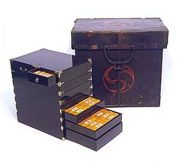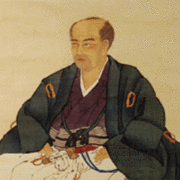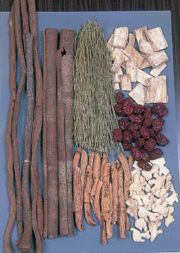Category:CD
(→{{Bilingual|漢方の基準 <small>(一般用漢方製剤承認基準)</small>|The Standards for Kampo Formulas}}) |
m (→{{Bilingual|イギリス医薬やドイツ医薬とは言わないのに?|But don't we say English or German medicine?}}) |
||
| Line 26: | Line 26: | ||
==={{Bilingual|イギリス医薬やドイツ医薬とは言わないのに?|But don't we say English or German medicine?}}=== | ==={{Bilingual|イギリス医薬やドイツ医薬とは言わないのに?|But don't we say English or German medicine?}}=== | ||
| + | {| | ||
| + | | | ||
| + | [[Image:HanaokaSeishu.gif|thumb|{{Bilingual|文化元年(1804年)、漢方処方で全身麻酔を成功させた華岡青洲 ([http://ja.wikipedia.org/wiki/%E8%8F%AF%E5%B2%A1%E9%9D%92%E6%B4%B2 Wikipediaより転載])彼が考案し現在も処方されるものに[[Kampo:Shiunko|紫雲膏]]、[[Kampo:Chuoko|中黄膏]]、[[Kampo:Jumihaidokuto|十味排毒湯]]。|Hanaoka Seishu, who succeeded in breast cancer surgery (with record) under general anesthesia with Kampo medicine in 1804 (see [http://en.wikipedia.org/wiki/Hanaoka_Seish%C5%AB Wikipedia]). Some of his recipes are still officially approved and used: [[Kampo:Shiunko|Shiunko]], [[Kampo:Chuoko|Chuoko]], and [[Kampo:Jumihaidokuto|Jumihaidokuto]].}}]] | ||
| + | |valign="top"| | ||
{{Twocolumn| | {{Twocolumn| | ||
| − | Western medicine is based on chemical structures, and each structure is (or was) patented. In this sense, their origin is clear. On the other hand, traditional herbal medicine is one major intellectual-property issue related to biological diversity. It is therefore important to clarify origins and install an appropriate international standard. | + | Western medicine is based on chemical structures, and each structure is (or was) patented. In this sense, their origin is clear. On the other hand, traditional (especially herbal) medicine is one major intellectual-property issue related to biological diversity. It is therefore important to clarify origins and install an appropriate international standard. |
| | | | ||
西洋薬は化合物に基づくため、それぞれの構造には特許が申請されていて、権利の帰属が明らかです。 | 西洋薬は化合物に基づくため、それぞれの構造には特許が申請されていて、権利の帰属が明らかです。 | ||
| Line 33: | Line 37: | ||
このため、伝統医薬の起源を明らかにし、適切な国際標準化をおこなうことが大切です。 | このため、伝統医薬の起源を明らかにし、適切な国際標準化をおこなうことが大切です。 | ||
}} | }} | ||
| + | |} | ||
;{{Bilingual|用語のまとめ|Summary}} ([[Index:CDterminology|{{Bilingual|詳細|more}}]]) | ;{{Bilingual|用語のまとめ|Summary}} ([[Index:CDterminology|{{Bilingual|詳細|more}}]]) | ||
Revision as of 00:21, 22 December 2010
Kampo/Crude Drug Wiki (漢方・生薬Wiki)
Contents |
M e n u
| Crude-drug Top Gallery |
General Index | Names | Prescriptions | Books | Journals | Terminology | Chinese Medicines |
Kampo Medicine
Kampo ≠ Chinese Medicine
|
In the WHO document, Kampo is defined as "the medicine traditionally practiced in Japan, based on ancient Chinese medicine". We might call it "the traditional Japanese medicine" but this expression should include acupuncture and moxibustion treatment and is a larger concept than Kampo. |
 Portable Medicine Cabinet (Edo era; 1862) Reproduced with permission from Naito Museum of Pharmaceutical Science and Industry |
But don't we say English or German medicine?
 Hanaoka Seishu, who succeeded in breast cancer surgery (with record) under general anesthesia with Kampo medicine in 1804 (see Wikipedia). Some of his recipes are still officially approved and used: Shiunko, Chuoko, and Jumihaidokuto. |
Western medicine is based on chemical structures, and each structure is (or was) patented. In this sense, their origin is clear. On the other hand, traditional (especially herbal) medicine is one major intellectual-property issue related to biological diversity. It is therefore important to clarify origins and install an appropriate international standard. |
- Summary (more)
- Kampo Medicine
Mixed recipes of crude drugs in Japanese distinct style, originally based on classic literature such as "Shokanron" and "Kinkiyoryaku" from ancient China. - Traditional Chinese Medicine (TCM)
Mixed recipes of crude drugs in China. It is more flexible depending on patients' conditions and uses hundreds of raw materials from plants as well as animal origins. - Folk Medicine
Usually single crude drugs used by tradition or hunch.
- Society Information
The Standards for Kampo Formulas
|
|
 Recipe for "Kakkonto", or pueralia root decoction (More) |
- 一般用漢方製剤承認基準 (PDF in Japanese by MHLW)
Japanese Pharmacopoeia
Japanese Pharmacopoeia is a law
(Japanese) Pharmacopoeia is a book with legal force containing directions to identify and qualify medicinal compounds that may be used in Japan. Its revision process therefore requires utmost attention. Since it is a legal document, there are some side effects such as for the scientific name of Cinnamon.
- Crude Drugs in Kampo Medicine
- Japanese Pharmacopoeia (English version by MHLW)
Literature Information
This site contains 7677 article information on Kampo formulas. They are listed at the bottom of each page for Kampo prescription.
Availability, Production Methods, Examinations
Image Gallery
Pages in category "CD"
The following 8 pages are in this category, out of 8 total.